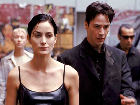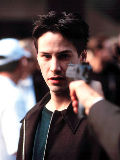The Matrix
The Matrix
I loved The Matrix – loved the action, loved the situation and characters, but most of all, I loved the idea behind the film. It was Samuel Taylor Coleridge, the 19th century poet and literary critic who coined the concept known as the willing suspension of disbelief. What he says is basically this: when we, the viewer, reader or audience, approach a work of art, we must leave our own personal beliefs, our own personal perception of reality, behind so we can approach the work on its own merits, on its own level. In other words, we must willingly suspend our disbelief no matter how distant the story line strays from what we believe to be true. All thoughts of what we believe to be true have to suspended; our “reality” has to be left behind to “the work.”
The Matrix (Larry and Andy Wachowski) is an incredible blend of action movie that embodies interesting content and dynamic visual execution.
The opening scene lets us in on what’s going to follow. Now, this is no normal action sequence of fists flying, shots fired and a few explosions. This is a totally unique ass grabbing sequence; first, not only does it pit a lone woman against four, maybe more, policeman, all armed and wearing bullet proof vests, but right before our eyes, in amazing physical feats, Trinity manages to escape. We’re with her as she leaps from rooftop to rooftop, building to building, defying gravity in her death defying escape from the Sentient Agents. She literally flies through the air, reaches the “other side,” then on foot, races the garbage truck to reach the ringing telephone. She manages to get there first and just answers the phone before the truck slams directly into the telephone booth. It is a miraculous escape.
Whoa.if that’s not a grabber, I don’t know what is. In terms of information, we still don’t know anything, we don’t know who Trinity is, or whether she’s a “good guy” or a “bad guy,” nor do we know what the story’s about, or how she managed to escape the way she did. But it’s an opening that grabs our attention immediately.
 At this point, we still don’t know what’s going on. Because the filmmakers have completely grabbed our attention, it’s precisely at this moment that we need information; we need to know what the story is about, who’s the main character, and what’s the dramatic situation. In dramatic terms, exposition is defined as the necessary information needed to move the story forward. Trinity tells Neo that he’s in danger because he’s expressed the desire to know who or what the Matrix is. She stresses “the truth is out there, Neo and it’s looking for you and will find you, if you want it to.” Then she’s gone.
At this point, we still don’t know what’s going on. Because the filmmakers have completely grabbed our attention, it’s precisely at this moment that we need information; we need to know what the story is about, who’s the main character, and what’s the dramatic situation. In dramatic terms, exposition is defined as the necessary information needed to move the story forward. Trinity tells Neo that he’s in danger because he’s expressed the desire to know who or what the Matrix is. She stresses “the truth is out there, Neo and it’s looking for you and will find you, if you want it to.” Then she’s gone.
I bought that immediately. Later, we’ll learn that we’re in parallel universe and the matrix is a state of virtual reality, an illusion, maya, as the ancient scriptures say, and we’ve been programmed to accept it as real. But the truth is that the “real” world has been recreated by a race of machines, called AI, artificial intelligence. In this scenario, the computers have literally re-created the world in the form of virtual reality.
Morpheus is dedicated to waging war against the Matrix to reveal the truth and liberate humanity from the bondage of the machines. Their hope, Morpheus believes, lies in finding “the One,” a human being endowed with God-like powers that will lead them in their war of liberation. And he believes Neo is “the One”. Even though the mind and body are entwined with each other, they are separate entities; therefore, if you control the mind, you can control reality and your own destiny.
This is demonstrated with Neo at work; he receives a package and a cell phone pops out, ringing. Morpheus is on the line. They’re after you, he says, and there’s only two ways to leave the building; either you choose to leave by the scaffolding hanging outside the window, or you choose to leave in their company. Neo is forced to choose, and this theme of choice is a recurring motif throughout the film. Like Hamlet, or the warrior Arjuna in the classic Indian epic, the Bhagavad Gita, Neo embodies the stance of the reluctant hero and before he can rise to another, higher level of consciousness he must accept who he is, accept his destiny.
Everything we’ve seen so far has been to set up and establish the story, the characters and the premise. It gives us all the information we need to move to the next story progression. Neo meeting Morpheus is the Plot Point at the end of Act I.

From now on, the story progresses by action and explanation. Is Neo really “the One” as Morpheus and the rebels believe? Finding the answer is Neo’s dramatic need and powers the story forward. Only when he can accept being “the One”, can he really be “the One.” What we believe to be true, is true..
Action and explanation. During their meeting, Morpheus offers him a choice; the blue pill and ordinary reality, or the red pill and the truth. There’s no hesitation. Neo takes the red one. Reality distorts as he falls through the corridors of reality into the nether world and be reborn.
Once Neo is reborn, he must re-train both body and mind; he learns martial arts via a computer program, acquires extraordinary leaping abilities, and begins to comprehend that while he inhabits the virtual reality of the Matrix, his mind is limited. Freed from the constraints of the limited mind, he can explore the untapped resources of his unlimited self. His struggle to free himself from these limitations is what guides him to the understanding that only he can choose to wear the mantle of “the One.” This is the same journey that is undertaken by the great Beings and the great Saints in Eastern religion and philosophy. Only when we can give up the concepts of the limited self can we attain enlightenment and liberation. Educating his mind and body carries the action forward through the first half of Act II. Once Neo completes his training, Morpheus takes him to meet The Oracle.
Neo’s encounter with the Oracle is the Mid-Point of the story. When she casually asks if he believes he’s “the One,” Neo shakes his head; “I’m just an ordinary guy.” Once again, his belief systems, the limitations of his own mind, imprison him. Too bad, she says. Why? Neo asks. “Because Morpheus believes in you Neo, and no one, not even you or me, can convince him otherwise,” she says. “He believes it so blindly that he’s going to sacrifice his life for you. You’re going to have to make a choice. On one hand, you’ll have Morpheus’s life… and on the other hand, you’ll have your own. One of you is going to die..Which one, will be up to you.”
The Oracle is a great character. She goes against all our expectations of what we normally would expect. Ordinarily, we would expect the Oracle to be an old, old, old man, extremely wise, with white hair and possibly a long straggly beard. Instead, we’re surprised to discover a middle-aged woman baking cookies. She is his “mirror;” she reflects what he believes, then tells him what she sees. Gradually, the reluctant hero assumes the mantle of faith, accepts the challenge of being “the One,” in much the same way Hamlet and Arjuna, both realize they must accept their fate. Neo is “the One” who has been chosen to “set the times right,” whether he likes it or not.
The Oracle’s prophecy is coming true, and no matter whether Neo thinks he’s “the One” or not, he’s determined that he’s not going to let Morpheus die at the hands of the Matrix.
“The Oracle told me this would happen,” Neo says. “She told me I would have to make a choice.” He pauses, then says, “I may not be what Morpheus thinks I am, but if I don’t try to help him, then I’m not even what I think I am..I’m going in after him.” When he declares himself in this fashion, he has accepted his role as “the One.”

Plot Point II takes us into the resolution of the story.
Tank loads up Neo and Trinity with an armory of guns, and they’re off. In another fantastic action sequence, incorporating wild stunts and inventive computer graphics, Neo rescues Morpheus. As they leave the Matrix, after Morpheus and Trinity are beamed up to the mother ship, Agent Smith appears and after a long and arduous battle, Neo succumbs to Agent Smith and dies.
And here’s where our belief systems come into play. The scriptures say love is the most powerful force in the world. The capacity of the human heart knows no bounds; it is the hub of all sacred places. Love is so strong it can remain embedded in our collective unconscious and can endure for lifetime after lifetime. Love is so strong it can even bring the dead back to life. Look at Jesus. Love is a force that never dies.
Trinity, standing over Neo’s inert body, now shares with him what the Oracle has told her; that she would fall in love with the man who was “the One.” Even though Neo’s dead, she believes with all her heart what the Oracle told her. Love is stronger than the physical body. “Now get up,” she demands. Neo’s eyes flip open, and he’s resurrected. A miracle? Of course. Once again, he has died so he can be reborn as “the One.” How? It doesn’t matter how. Either we believe it or we don’t; it is the willing suspension of disbelief. He has overcome the limitations of his mind and has become liberated. He has chosen to wear the mantle of “the One.”
At the end, Neo mingles with a crowd in the Matrix. And he tells us that “I know you’re real proud of this world you’ve built, the way it works, all the nice little rules and such, but I’ve got some bad news.I’ve decided to make a few changes.” Then there’s a RUSH of air and Neo shoots by, “coat billowing like a black leather cape as he soars up, up, and away.”
Fade Out. The End.



Justin, Thank you so much for your link to my late husband’s analysis of “The Matrix.” I wish you all the best with your writing and your children, especially the delightfully named Elderbeast. 🙂 Aviva Field